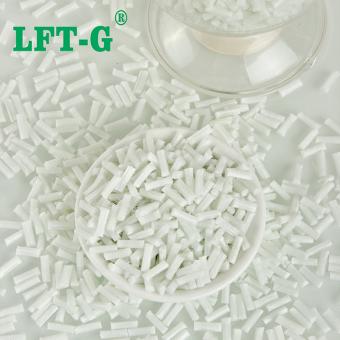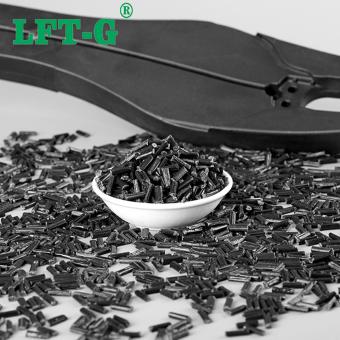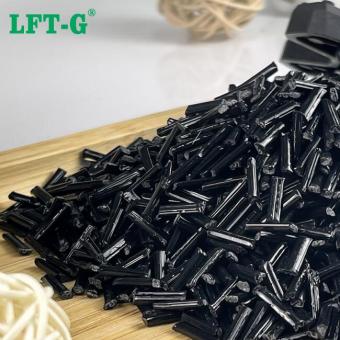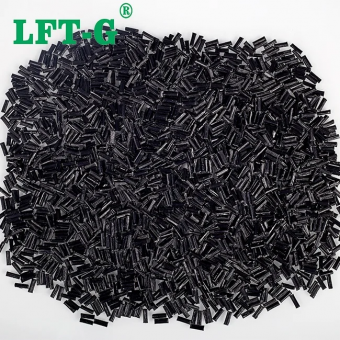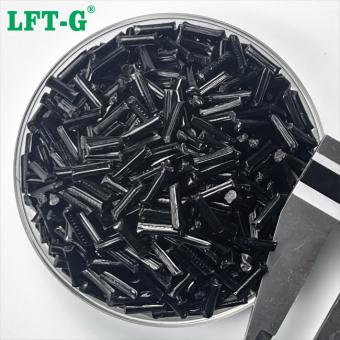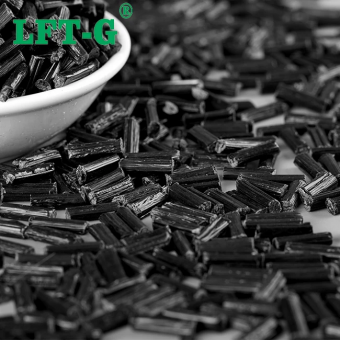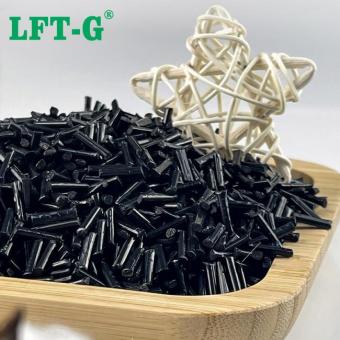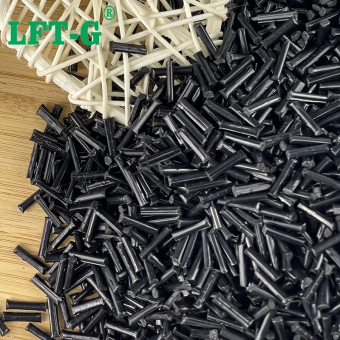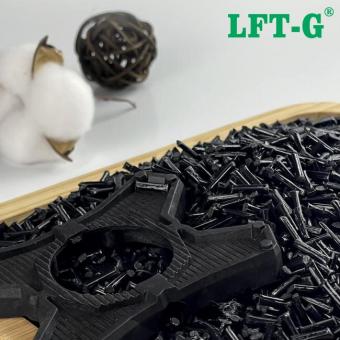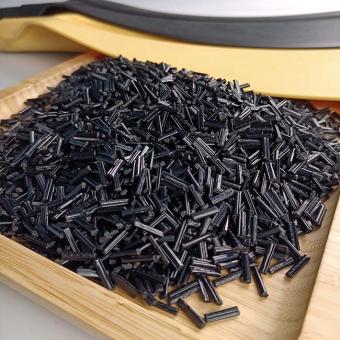-
Xiamen LFT PLA Polylactic acid compounds long glass fiber thermoplastic resin for engineeringPLA plastic PLA is a non-natural polyester, which is considered as one of the most promising "green plastics" because of its excellent properties such as biocompatibility, biodegradability and high mechanical strength. PLA has good degradability and can be completely degraded by microorganisms. Products made of PLA can be completely degraded to CO2 and water after use, and are non-toxic and non-irritating. PLA has similar mechanical properties to polypropylene, while its gloss, clarity and processability are similar to polystyrene, and its processing temperature is lower than that of polyolefin. PLA can be processed into various packaging materials, fibers and nonwovens through injection molding, extrusion, blistering, blow molding, spinning and other general plastic processing methods, and PLA has been widely used in disposable plastic products. In addition, PLA can also be widely used in chemical, medical, pharmaceutical and 3D printing industries. It is now increasingly recognized that PLA polyesters will play a key role in solving the plastic pollution problem. PLA reinoforced plastic Glass fiber (English name: glass fiber or fiberglass) is an inorganic non-metallic material with excellent performance, the advantages of good insulation, heat resistance, good corrosion resistance, and high mechanical strength. One of the main uses of glass fiber for the reinforcement of composite materials. Long glass fiber generally refers to the length of more than 10mm glass fiber. Long Glass Fiber Reinforced PLA plastic refers to modified PLA composites containing glass fiber lengths of 10 to 25 mm, which are formed into a three-dimensional structure with glass fiber lengths greater than 3.1 mm through injection molding and other processes, and is referred to as Long Glass Fiber PLA, abbreviated as LGFPLA. fiber reinforce thermoplastic). From the material definition, LGFPLA is a kind of LFT. Generally, they are columnar particles of 12mm or 25mm in length and about 3mm in diameter. The pellets of about 12mm length are mainly used for injection molding, while the pellets of about 25mm length are mainly used for compression molding. In these pellets, the glass fiber has the same length as the pellets, and the glass fiber content can vary from 20% to 60%, and the color of the pellets can be color-matched according to customer requirements. LGF & SGF LFT has the following advantages over short fiber reinforced thermoplastic composites: - Longer fiber length, which significantly improves the mechanical properties of the products. - High specific stiffness and specific strength, good impact resistance, especially suitable for automotive parts applications. - Improved creep resistance, good dimensional stability, and high precision of part molding. - Excellent fatigue resistance. - Better stability in high temperature and humid environment. - Fibers can move relatively in the molding mold during the molding process, with little fiber damage. Details Number Color Length Fiber specification Package Sample Port of loading Delivery time PLA-NA-LGF Natural color or as customized 6-25mm 20%-60% 25kg/bag Available Xiamen Port 7-15 days after shipment Lab & factory Xiamen LFT composite plastic Co., Ltd. The rapid development of technology has led to the emergence of LFT carbon fiber composites. Long Fiber (Xiamen) New Material Technology Co., Ltd, provides professional customization service for modified reinforced long carbon fiber composites. Ltd. was founded by a veteran of the thermoplastic reinforced composite industry, focusing on the development and production of (LFT-G.LFRT,LFT) long glass/carbon fiber reinforced thermoplastic engineering plastics. The company produces long carbon fiber composites with the advantages of light weight, high strength, high impact thermal resistance, design and recycleable, green and environmental protection. Compared with traditional materials, it requires lower cost, better corrosion and chemical resistance, and better molding and processing performance, making it the golden material of the 21st century. Long Fiber (Xiamen) New Material Technology Co: Xiamen LFT composite plastic Co., Ltd. is engaged in the development and production of LFRT series of long glass fiber (LGF) and long carbon fiber (LCF) PP, PA6, PA66, PPA, PA12, TPU, PBT, PLA, PET, PPS, PEEK and other engineering plastics. Series of products can be used in the manufacture of home appliances, aerospace, automotive, military, electrical and other parts, such as gears, rollers, pulleys, drums, pump impellers, fan blades, etc. They can also be used in the manufacture of medical equipment, sporting goods, daily necessities and other fields.
- PLA reinforced plastic lgf production pla
- LFT-G PLA injection mold modified materials
- long glass fiber compounds pla resin basic
- PLA pellets of long fiber 30 made in China
- Self owing PLA polymers manufacturer direct sell
- PLA pure pellets virgin grade lft
Tags :
-
Xiamen LFT-G HDPE filling long glass fiber thermoplasitc reinforced compoundsHDPE-LGF High density polyethylene (HDPE)/ glass fiber (LGF) composites were prepared by twin-screw extrusion mechanism, and the mechanical properties and non-isothermal crystallization behavior of HDPE/LGF composites were studied. The results show that the impact strength of the composite can be improved by MAH-g-POE, and the interface bond between the glass fiber and HDPE is good. The Avrami index (n) of the composite does not change with the cooling rate. Datasheet Application Package Xiamen LFT composite plastic Co.,Ltd Come and find us! We will offer you: 1. LFT & LFRT material technical parameters and leading edge design. 2. Mold front design and recommendations. 3. Provide technical support such as injection molding and extrusion molding.
- HDPE filling lgf20
- lgf hdpe composite materials
- reinforced hdpe plastic resin
- long glass fiber hdpe
- Thermoplastic hdpe lgf
- hdpe resin compounds
Tags :
-
Xiamen LFT Polyamide 12 Long Carbon Fiber Composite Nylon Pellets PolymerLFT PA12 Long Carbon Fiber Composite Data Sheet and Technical Guidance
- Long Carbon Fiber Composite high strength
- LFT PA12 Long Carbon Fiber for car parts
- Nylon 12 Pellets Polymer engineering plastic
- PA12 Granules thermoplastic resin instead metal
- Pa12 Pellets Polyamide lightweight
- PA12 Long Carbon Fiber Composite
Tags :
-
Xiamen LFT PLA filling Long carbon fiber Reinforced polylactic acidPLA materials are current pioneering materials in biodegradable materials. Long carbon fiber Reinforced polylactic acid PLA modified materials are likely to become global advantages in future green materials.
- PLA long carbon fiber high rigidity and strength
- Reinforced polyactic pla instead metal
- PLA composite green materials
- long carbon fiber with PLA modification
- PolyacticDegradable material
Tags :
-
Xiamen LFT Polypropylene PP Copolymer with Long Carbon Fiber Reinforcement PolymersLong fiber reinforced thermoplastics are an excellent option to consider for metal replacement at a fraction of the weight.
- Plastic increased mechanical properties
- Customization materials high quality ISO
- Injection molding plastic engineering factory
- LCF Carbon fiber filled thermoplastic resin
- long length pellets compounds manufacturer
- Continuous fibre long cut good performance
Tags :
-
Xiamen LFT Flame Resistance Polyphenylene Sulfide Long Carbon Fiber Reinforced CompoundsPolyphenylenesulfide, is a thermoplastic special engineering plastic with excellent comprehensive properties.
- pps fiber special thermoplastic resin
- Engineering plastics high mechanical properties
- new materials instead metal steel
- Injection molding made in China plastic
- demanding industrial applications
- carbon fiber natural color enhanced
Tags :
-
LFT Polyamide 66 high performance long carbon fiber reinforcementPolyamide 66 roving carbon fiber Nylon black color with heat resistance
- Long carbon fiber enhance pellets
- Roving carbon fiber PA66 instead metal and steel
- Nylon66 composite granules for injection
- High quality PA66 long fiber composite、
- Polyamide long fiber composite
- Virgin plastic PA6 LCF40 for car parts
Tags :
-
LFT Polyamide 66 high performance long carbon fiber reinforcementPolyamide 66 roving carbon fiber Nylon black color with heat resistanceview more
-
Xiamen LFT PLA filling Long carbon fiber Reinforced polylactic acidPLA materials are current pioneering materials in biodegradable materials. Long carbon fiber Reinforced polylactic acid PLA modified materials are likely to become global advantages in future green materials.view more
-
LFT Polypropylene reinforced plastic long carbon fiber higher performance 12mm natural colorPP material PP is a polymer made of propylene as monomer by coordination polymerization, and is one of the five major general-purpose plastics PE, PP, PVC, PS and ABS. 1. colorless, tasteless, five toxic, unadded PP material compounded with FDA and other food-grade material requirements; 2. due to the crystalline nature of PP, the original color milky white translucent, better transparency than PE; 3. low specific gravity of 0.9, almost one of the lightest plastics than water; 4. good toughness, especially repeated resistance to bending ability, commonly known as 100 fold rubber; 5. better heat resistance than PE, which can reach up to 120°C; 6. good resistance to hydrolysis and can be sterilized by high temperature steam 7. good chemical resistance, especially acid resistance, can be due to the storage of concentrated sulfuric acid containers; 8. outdoor use is susceptible to light, ultraviolet light and other aging. Modified PP material PP material by filling carbon fiber can increase the rigidity and modulus of PP material, reduce the material deformation caused by shrinkage, but at the same time the material toughness decreases. By adding anti-UV agent, anti-aging agent can improve the outdoor use performance of PP, and adding flame retardant material can improve the flame retardant performance of PP. TDS for reference only SGF VS LGF Long carbon fiber specification Application Product processing We will offer you 1. LFT&LFRT material technical parameters and leading edge design 2. Mold front design and recommendations 3. Provide technical support such as injection molding and extrusion molding
- carbon fiber reinforced plastics granules
- long carbon fiber reinforced pp
- long fiber compounds pp
- long fiber composite PP granules
- long carbon fiber polypropylene
Tags :

 e-mail
e-mail English
English français
français Deutsch
Deutsch русский
русский italiano
italiano español
español português
português العربية
العربية 日本語
日本語 한국의
한국의 中文
中文












